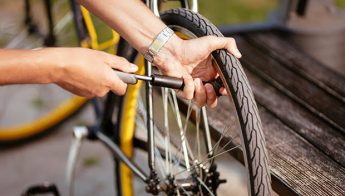Introduction
Quick Navigation
Biking is an interesting sport especially when to get the chance to go as far as 30 to 50 miles without having any obstruction on your pavement, you’ll feel excited and wish to keep riding forever. But hey, you’ve to be safe! And to be safe you’ve to take good care of your bike and all its parts, especially the tires.
You’ll need to know how to keep your tires clean, when to replace them and how long they last. Whenever you go sporting, your safety is very crucial and biking isn’t an exception. Whether you’re exploring, on a tournament, riding the roads, or commuting, you need to be sure that both you and your bike are safe.
Keeping yourself safe in riding doesn’t mean wearing helmets alone, making sure that all the parts of your bike are healthy and okay is also very important. An important thing to take care of in your bike is the bike tires as they’re what will determine whether you’re having a fun, safe ride or a dreary one.
One of the most argued questions about road bike tires is the right time to change them, this is a tricky question that even tire manufacturers don’t answer. This is because they aren’t in control of the variables and don’t know how much you’ll be riding and the conditions the tires will pass through, so all they do is give some tips that will help you increase the lifespan of your tires.
In this article, we’re going to take a look at how long do road bike tires last. We’ll also discuss some warning signs that will give you an indication it’s time to get new tires. Leggo!
[BOLD](How long do road bike tires last: Their life expectancy)
There are many factors to determine the life expectancy of your tires. However, experts have come up with an average lifespan that your tire is expected to last.
Commonly, you’ll get somewhere between 1000 to 3000 miles out of an average road bike tire. However, some average tires can last more than this or less than it as we’ve said, there are many factors like thickness, brand, where you ride on & others that greatly affect the lifespan of tires.
For specialized tires, like those that are puncture-resistant or made for touring, you can get somewhere from 3000 miles upwards. However, most racing tires are minimalist and focus on giving you the best speed so they tend to last just like average tires before they’ll need to be replaced.
From the above explanation, we can conclude that we can’t say the actual life expectancy of any tire, rather we’ll just assume based on the type, the brand, and other determining factors. Now let’s look at warning signs of aging tires.
[BOLD](Warning signs of an aging tire)
As earlier mentioned you can’t say the life expectancy of a tire. However, there are some things that you can check to see if your road bike tire is still in good shape or it needs to be replaced.
Below are some signs that will highlight that your bike tire is aging and need to be replaced.
[BOLD](The Treads of the tire)
One of the easiest and fastest ways to know if your tres are aging is by checking their tread.
Treads are the intentional dips of rubber that are all over your tires. Unlike car tires that have many treads, road bike tires come will little tread especially racing tire models so it’s not easy to know if the treads are fading away. If possible, take a photo of your tires when you first bought them & be comparing them with what your tires are looking like as time goes on.
If you go bike tires that don’t have treads at all, be examining your contact patch (The area that goes over the bike’s tire and makes contact with the road as you ride). When you notice that it has started getting worn out, then it’s high time you replace your tires.
[BOLD](Criss Cross Treads)
The protection belt of a tire is a piece that’s seen underneath the rubber of each tire. This belt is made from a carcass in a diagonal crisscross pattern.
If the crisscross pattern started showing on any part of your tire, then take that as a warning sign that your tires are getting older and worn out, so they need to be replaced.
While it’s advisable you change your tires immediately you start noticing the crisscross treads, you should know that they’re only a sign that shows you your tires are approaching death & you should budget with replacing them soon.
[BOLD](Disasters)
There are certain things that you can’t avoid when riding on the road. These minor accidents can get chunks of cuts into your tire. Check your tire closely and see if you’ll notice any flat spots, rips, punctures, cuts, or tears, if you see any then there’s a need to replace your tires sooner.
However, this depends on you and the type of issue your tire experience. Usually, you might not need to replace your tire after the first cut or puncture, but if the road you’re riding on is rough, it’s advisable to replace your tires to be on a safer side.
Also, if your tires are having bulges or if some of its areas are snaking back and forth when it’s spun, then you’ll have to change those tires as soon as possible.
This is because snaking is a result of the interior treads of a tire separating. This might lead to your tire failing quickly when you’re riding at a fast speed, which will put you in great danger as you won’t be able to atop your bike.
Another thing to look for on your tires is tumor-like outgrowth which indicates weakness in the rubber of the tire. Don’t ride with a tire having these bulges as you might end up having a blowout as you ride.
Let’s not forget about Rips that usually happen when you’re out riding! If your tire gets one, it will probably need to be replaced though you can temporarily fix it with a dollar bill or a tire book patch. But please, replace those tires as soon as possible.
[BOLD](The sidewalls of your tire)
Another area you’re expected to be taking a good look at is the sidewalls of the tire otherwise known as the tire flank. It is one of the best spots to know if your tires are healthy and fit or if they’ve worn out and need to be replaced.
A new healthy tire will have a full sidewall, if you notice your sidewall is getting thinner then there’s the need to perform some maintenance If the tires are new. On the other hand, If your sidewalls are getting thinner as a result of old age, you’ll also start seeing cracks and threads on them which indicates old age or lack of maintenance, and you’ll have to replace that tire.
[BOLD](Lack of maintenance)
Lack of maintenance is one of the signs that you’re going to replace your tire sooner than later. I guess you aren’t one of those that neglect their road bike tires leading to a decrease in its life span.
If you don’t want to be replacing your tires frequently, then please be taking good care of them, keep them clean, monitor their pressures, and look out for any issues. Many tires wear out easily because their riders aren’t giving them the required care. For example, if you are not monitoring the pressure of your tires and you end up riding on low-pressure tires, the sidewalls will start to lose their rigidity and be bending slowly. This in turn will cause premature aging in your tires forcing you to replace them much quicker than you’re expected to do.
Conclusion
Taking good care of your road bike tires is very essential if you want them to last long. Though the type of tire can highlight its life expectancy, some factors like neglecting your tires, riding on rough pavements, or even buying cheap low-quality tires will lead you to replace tires frequently and spend a lot in the long run. While you can check for signs of aging using the above guide, it’s also advisable to be taking your bike to a professional bike shop for tuning from time to time to know how healthy your tires and other parts of your bicycle are.
Check out the review of some bikes & bike parts below:
2x Absolute Black Premium Subcompact chainrings review‘
Brooks Cambium c13-145 all Weather Review‘

